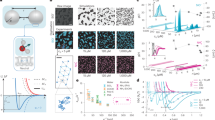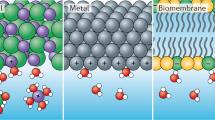Abstract
Nikolaides et al.1 propose that the puzzling attraction that occurs between micrometre-sized particles adsorbed at an aqueous interface is caused by a distortion of the liquid interface that is due to the dipolar electric field of the particles and which induces a capillary attraction. Here we argue that this effect cannot account for the observed attraction, on the fundamental grounds that it is inconsistent with force balance.
Similar content being viewed by others
Main
To estimate the influence of the surface deformation, the authors assume that the sum total of the electrostatic pressure acting on the liquid interface is equivalent to an external force, F, pushing the particle into the water. The resulting deformation of the interface would give rise to a long-range interparticle interaction energy

where γ is the surface tension, r is the distance between particles, and r0 is an arbitrary constant. However, the electrostatic force acts on the particle and the liquid interface simultaneously, so equation (1) does not apply.
The force F on the sphere is balanced by surface tension, creating a dimple in the water surface. The shape of the dimple is governed by the Young–Laplace equation

If the force acts only on the particle, then the pressure difference across the interface δp≈0 and the radii of curvature R1 and R2 of the surface are equal but opposite (Fig. 1). The resulting water level around an isolated sphere would be h(r) = F/(2πγ) ln(r/r0) for small surface slopes, such that F ≈ 2πrcγh′(rc), where 2πrc is the length of the contact line. Owing to the long range of the logarithm, the force on the sphere is passed on to the rim of the vessel containing the liquid (Fig. 1, left).
The situation changes fundamentally when the force F is not external but originates from a surface pressure δp∝1/r6, as stated in ref. 1. Now the meniscus profile is h(r) = −F/(8πγ)(rc/r)4 — that is, very short range. The electrostatic force F pushing the sphere into the liquid is balanced by the sum total of electrostatic pressure on the liquid interface and there is no force on the rim of the vessel (Fig. 1, right). In contrast, by unquestioningly applying equation (1), one implicitly admits that there is also a force on the vessel, a force not balanced by any other force. This is inconsistent with Newton's third law.
Capillary attraction between spheres is caused by the overlap of their dimples, which reduces the total surface area of the water2. The resulting attraction energy is

for large r. This interaction has a much shorter range than that shown in equation (1), even a shorter range than the dipole– dipole repulsion between like-charged particles that is proportional to 1/r3, so overall there is no attraction at all. The capillary deformation of the interface contributes a mere 1.8 × 10−5 kT to the interaction potential, so it is insignificant thermodynamically. Thus, the mechanism proposed by Nikolaides et al.1 does not account for the observations, and the origin of the observed attraction remains enigmatic.
References
Nikolaides, M. G. et al. Nature 420, 299–301 (2002).
Stamou, D., Duschl, C. & Johannsmann, D. Phys. Rev. E 54, 5263–5272 (2000).
Author information
Authors and Affiliations
Corresponding author
Rights and permissions
About this article
Cite this article
Megens, M., Aizenberg, J. Like-charged particles at liquid interfaces. Nature 424, 1014 (2003). https://doi.org/10.1038/4241014a
Issue Date:
DOI: https://doi.org/10.1038/4241014a
This article is cited by
-
Single-particle tracking of the formation of a pseudoequilibrium state prior to charged microgel cluster formation at interfaces
NPG Asia Materials (2020)
-
In situ X-ray scattering observation of two-dimensional interfacial colloidal crystallization
Nature Communications (2018)
Comments
By submitting a comment you agree to abide by our Terms and Community Guidelines. If you find something abusive or that does not comply with our terms or guidelines please flag it as inappropriate.




